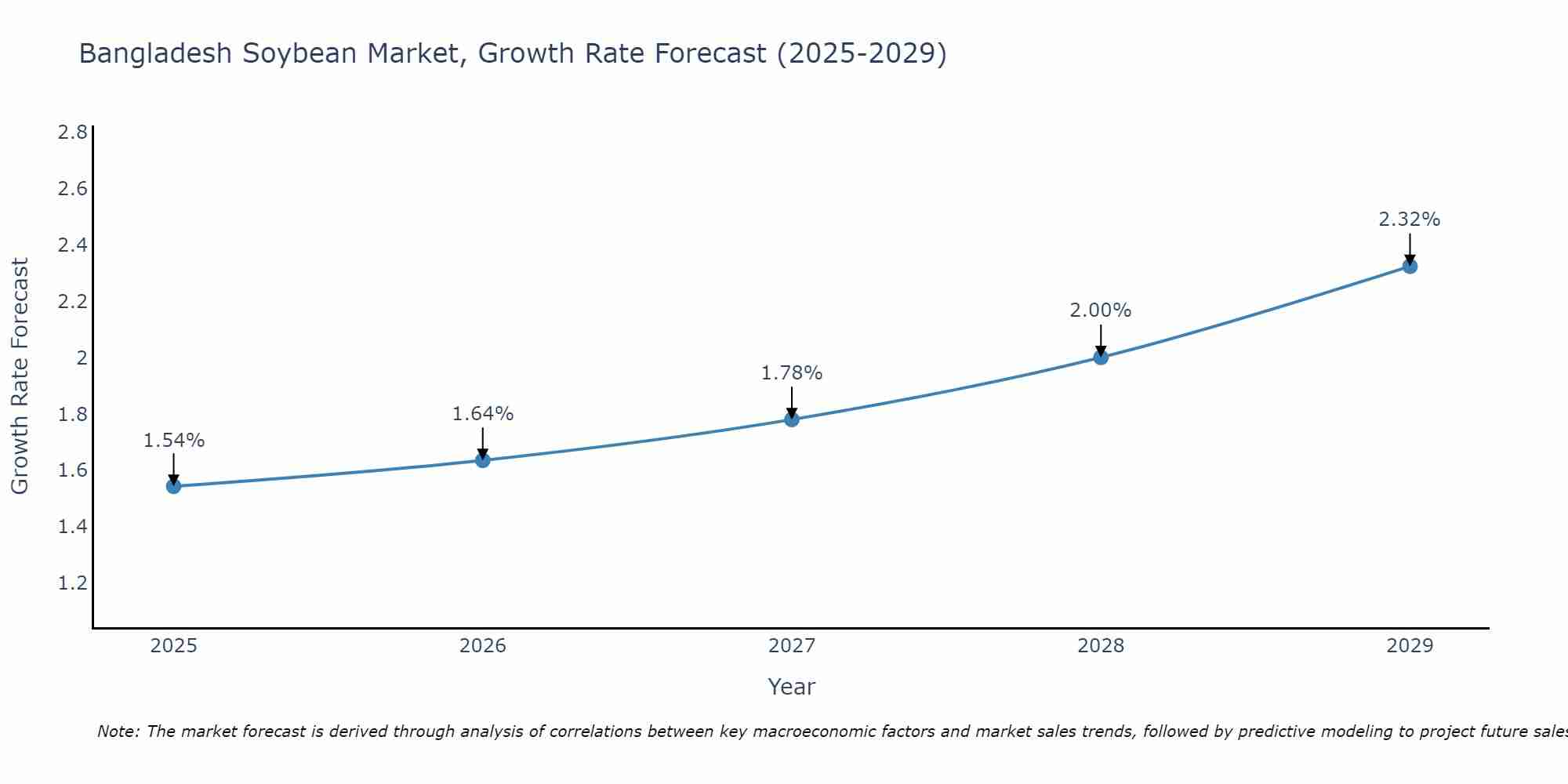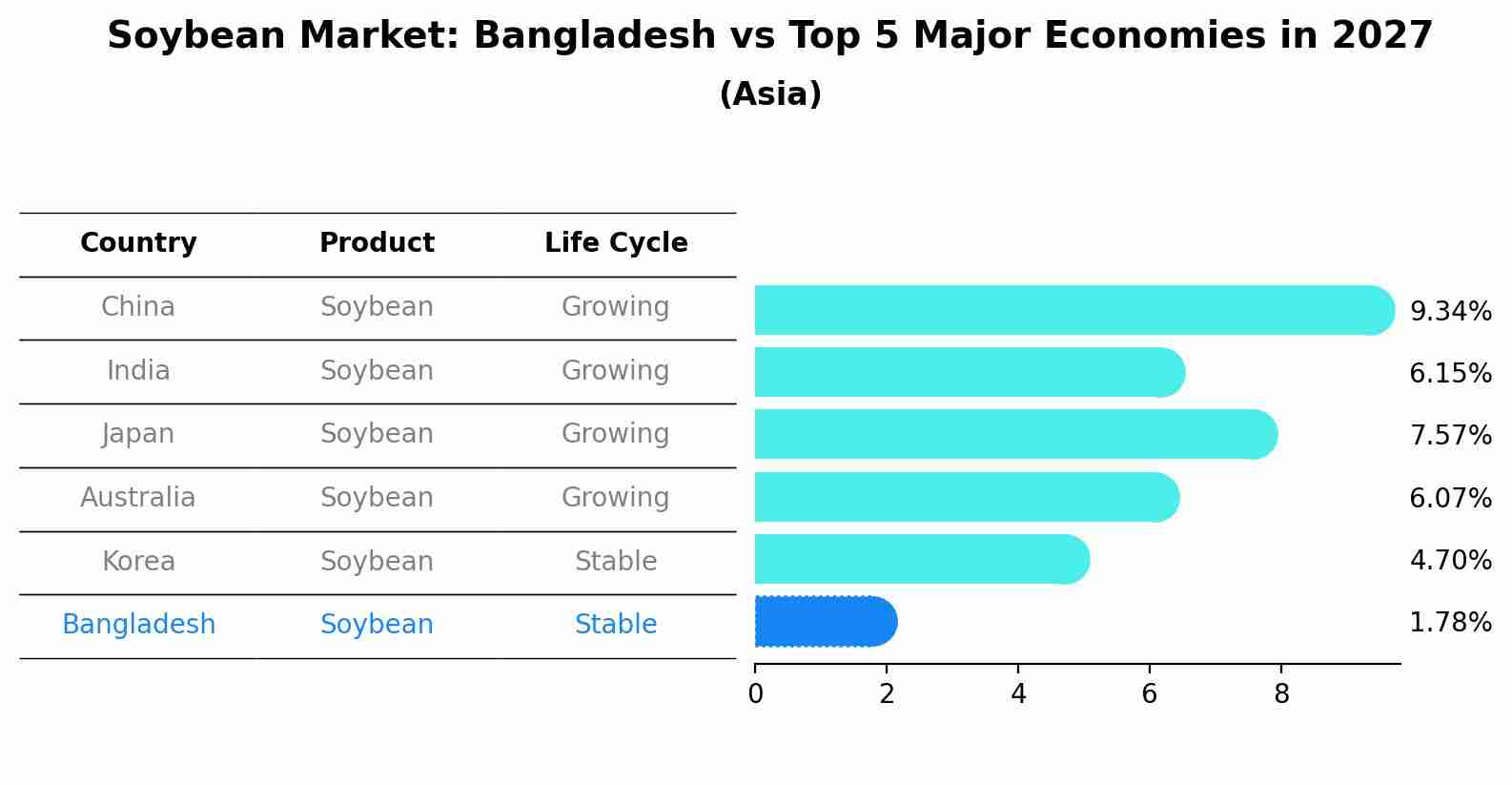Bangladesh Soybean Market (2025-2031) Outlook | Industry, Revenue, Analysis, Share, Value, Size, Forecast, Growth, Companies & Trends
| Product Code: ETC224672 | Publication Date: Aug 2022 | Updated Date: Aug 2025 | Product Type: Market Research Report | |
| Publisher: 6Wresearch | Author: Sumit Sagar | No. of Pages: 75 | No. of Figures: 35 | No. of Tables: 20 |
Bangladesh Soybean Market Size Growth Rate
The Bangladesh Soybean Market is poised for steady growth rate improvements from 2025 to 2029. Commencing at 1.54% in 2025, growth builds up to 2.32% by 2029.

Soybean Market: Bangladesh vs Top 5 Major Economies in 2027 (Asia)
Bangladesh's Soybean market is anticipated to experience a stable growth rate of 1.78% by 2027, reflecting trends observed in the largest economy China, followed by India, Japan, Australia and South Korea.

Bangladesh Soybean Market Overview
The Bangladesh soybean market is steadily growing due to increasing consumer awareness of the health benefits associated with soy products. Soybean imports have been on the rise to meet the growing demand for soy-based food products, particularly in the form of soybean oil and soybean meal used in cooking and animal feed, respectively. The market is primarily driven by the food processing industry, as soybeans are a versatile ingredient in various food products. Local production of soybeans is limited, leading to a heavy reliance on imports from countries like the United States, Brazil, and Argentina. The government`s initiatives to promote soybean cultivation and processing within the country are expected to further boost the market in the coming years.
Bangladesh Soybean Market Trends
The Bangladesh soybean market is currently experiencing a growing demand for soybean products driven by increasing awareness of the health benefits associated with soy consumption. The market is also witnessing a shift towards plant-based protein sources as more consumers are opting for vegetarian and vegan diets. Additionally, the government`s initiatives to promote soybean cultivation and processing within the country are expected to boost domestic production and reduce reliance on imports. However, challenges such as limited availability of arable land, fluctuations in global soybean prices, and competition from other oilseeds continue to impact the market. Overall, the Bangladesh soybean market is poised for growth with opportunities for expansion in both production and consumption sectors.
Bangladesh Soybean Market Challenges
In the Bangladesh soybean market, several challenges are faced, including limited domestic production leading to heavy reliance on imports, fluctuating global prices impacting local prices, lack of awareness and promotion of soy products among consumers, competition from other protein sources like fish and poultry, and inadequate infrastructure for storage and processing. Additionally, issues such as climate change affecting crop yields, limited availability of high-quality seeds, and inconsistent government policies further compound the challenges faced by stakeholders in the soybean market in Bangladesh. Overcoming these obstacles will require coordinated efforts from government bodies, industry players, and other stakeholders to improve production practices, promote consumption, enhance infrastructure, and address policy issues to foster a more sustainable and thriving soybean market in the country.
Bangladesh Soybean Market Investment Opportunities
Investment opportunities in the Bangladesh soybean market include vertical integration within the supply chain, such as establishing soybean processing plants to produce soybean oil and meal locally to meet the growing demand for edible oils and animal feed. Another potential opportunity is investing in technology and innovation to improve the efficiency of soybean cultivation and processing, thereby increasing yields and reducing production costs. Additionally, investing in marketing and distribution channels to reach a wider consumer base and capitalize on the increasing health consciousness among the population could be a lucrative option. Overall, the Bangladesh soybean market presents opportunities for investors to participate in a growing sector with the potential for sustainable growth and profitability.
Bangladesh Soybean Market Government Policy
The Bangladesh government has implemented several policies related to the soybean market to support domestic production and ensure food security. These policies include providing subsidies and incentives to farmers to increase soybean cultivation, promoting research and development in soybean farming techniques, and imposing import tariffs to protect domestic producers. Additionally, the government has introduced programs to improve the quality and efficiency of soybean production, such as providing access to high-quality seeds and equipment. These policies aim to reduce reliance on soybean imports, boost local production, and enhance the competitiveness of the Bangladesh soybean market. Overall, the government`s focus on supporting domestic soybean production is essential for ensuring food security and promoting self-sufficiency in the agricultural sector.
Bangladesh Soybean Market Future Outlook
The future outlook for the Bangladesh Soybean Market appears promising due to increasing consumer awareness and demand for plant-based protein sources. As the population becomes more health-conscious and environmentally aware, there is a growing trend towards incorporating soy-based products into diets. Additionally, the government`s efforts to promote domestic soybean production through incentives and support to farmers are expected to boost local supply. With a rising middle-class population and changing dietary preferences, the demand for soybean products such as soy milk, tofu, and soybean oil is projected to continue to grow in Bangladesh. However, challenges such as limited arable land and weather conditions may impact production levels, necessitating a balance between imports and domestic cultivation to meet the increasing demand.
Key Highlights of the Report:
- Bangladesh Soybean Market Outlook
- Market Size of Bangladesh Soybean Market, 2024
- Forecast of Bangladesh Soybean Market, 2031
- Historical Data and Forecast of Bangladesh Soybean Revenues & Volume for the Period 2021 - 2031
- Bangladesh Soybean Market Trend Evolution
- Bangladesh Soybean Market Drivers and Challenges
- Bangladesh Soybean Price Trends
- Bangladesh Soybean Porter's Five Forces
- Bangladesh Soybean Industry Life Cycle
- Historical Data and Forecast of Bangladesh Soybean Market Revenues & Volume By Applications for the Period 2021 - 2031
- Historical Data and Forecast of Bangladesh Soybean Market Revenues & Volume By Crush for the Period 2021 - 2031
- Historical Data and Forecast of Bangladesh Soybean Market Revenues & Volume By Feed Use for the Period 2021 - 2031
- Historical Data and Forecast of Bangladesh Soybean Market Revenues & Volume By Food Use for the Period 2021 - 2031
- Bangladesh Soybean Import Export Trade Statistics
- Market Opportunity Assessment By Applications
- Bangladesh Soybean Top Companies Market Share
- Bangladesh Soybean Competitive Benchmarking By Technical and Operational Parameters
- Bangladesh Soybean Company Profiles
- Bangladesh Soybean Key Strategic Recommendations
Frequently Asked Questions About the Market Study (FAQs):
1 Executive Summary |
2 Introduction |
2.1 Key Highlights of the Report |
2.2 Report Description |
2.3 Market Scope & Segmentation |
2.4 Research Methodology |
2.5 Assumptions |
3 Bangladesh Soybean Market Overview |
3.1 Bangladesh Country Macro Economic Indicators |
3.2 Bangladesh Soybean Market Revenues & Volume, 2021 & 2031F |
3.3 Bangladesh Soybean Market - Industry Life Cycle |
3.4 Bangladesh Soybean Market - Porter's Five Forces |
3.5 Bangladesh Soybean Market Revenues & Volume Share, By Applications, 2021 & 2031F |
4 Bangladesh Soybean Market Dynamics |
4.1 Impact Analysis |
4.2 Market Drivers |
4.2.1 Increasing awareness about the health benefits of soybeans |
4.2.2 Growing demand for plant-based protein sources |
4.2.3 Government initiatives to promote soybean cultivation in Bangladesh |
4.3 Market Restraints |
4.3.1 Limited availability of arable land for soybean cultivation |
4.3.2 Dependence on imports for soybean supply |
4.3.3 Price volatility in the global soybean market affecting local prices |
5 Bangladesh Soybean Market Trends |
6 Bangladesh Soybean Market, By Types |
6.1 Bangladesh Soybean Market, By Applications |
6.1.1 Overview and Analysis |
6.1.2 Bangladesh Soybean Market Revenues & Volume, By Applications, 2021 - 2031F |
6.1.3 Bangladesh Soybean Market Revenues & Volume, By Crush, 2021 - 2031F |
6.1.4 Bangladesh Soybean Market Revenues & Volume, By Feed Use, 2021 - 2031F |
6.1.5 Bangladesh Soybean Market Revenues & Volume, By Food Use, 2021 - 2031F |
7 Bangladesh Soybean Market Import-Export Trade Statistics |
7.1 Bangladesh Soybean Market Export to Major Countries |
7.2 Bangladesh Soybean Market Imports from Major Countries |
8 Bangladesh Soybean Market Key Performance Indicators |
8.1 Average yield per hectare of soybean cultivation in Bangladesh |
8.2 Percentage of agricultural land dedicated to soybean cultivation |
8.3 Adoption rate of modern farming techniques in soybean cultivation |
9 Bangladesh Soybean Market - Opportunity Assessment |
9.1 Bangladesh Soybean Market Opportunity Assessment, By Applications, 2021 & 2031F |
10 Bangladesh Soybean Market - Competitive Landscape |
10.1 Bangladesh Soybean Market Revenue Share, By Companies, 2024 |
10.2 Bangladesh Soybean Market Competitive Benchmarking, By Operating and Technical Parameters |
11 Company Profiles |
12 Recommendations |
13 Disclaimer |
- Single User License$ 1,995
- Department License$ 2,400
- Site License$ 3,120
- Global License$ 3,795
Search
Thought Leadership and Analyst Meet
Our Clients
Related Reports
- Afghanistan Apparel Market (2026-2032) | Growth, Outlook, Industry, Segmentation, Forecast, Size, Companies, Trends, Value, Share, Analysis & Revenue
- Canada Oil and Gas Market (2026-2032) | Share, Segmentation, Value, Industry, Trends, Forecast, Analysis, Size & Revenue, Growth, Competitive Landscape, Outlook, Companies
- Germany Breakfast Food Market (2026-2032) | Industry, Share, Growth, Size, Companies, Value, Analysis, Revenue, Trends, Forecast & Outlook
- Australia Briquette Market (2025-2031) | Growth, Size, Revenue, Forecast, Analysis, Trends, Value, Share, Industry & Companies
- Vietnam System Integrator Market (2025-2031) | Size, Companies, Analysis, Industry, Value, Forecast, Growth, Trends, Revenue & Share
- ASEAN and Thailand Brain Health Supplements Market (2025-2031) | Strategy, Consumer Insights, Analysis, Investment Trends, Opportunities, Growth, Size, Share, Industry, Revenue, Segments, Value, Segmentation, Supply, Forecast, Restraints, Outlook, Competition, Drivers, Trends, Demand, Pricing Analysis, Competitive, Strategic Insights, Companies, Challenges
- ASEAN Bearings Market (2025-2031) | Strategy, Consumer Insights, Analysis, Investment Trends, Opportunities, Growth, Size, Share, Industry, Revenue, Segments, Value, Segmentation, Supply, Forecast, Restraints, Outlook, Competition, Drivers, Trends, Demand, Pricing Analysis, Competitive, Strategic Insights, Companies, Challenges
- Europe Flooring Market (2025-2031) | Outlook, Share, Industry, Trends, Forecast, Companies, Revenue, Size, Analysis, Growth & Value
- Saudi Arabia Manlift Market (2025-2031) | Outlook, Size, Growth, Trends, Companies, Industry, Revenue, Value, Share, Forecast & Analysis
- Uganda Excavator, Crane, and Wheel Loaders Market (2025-2031) | Strategy, Consumer Insights, Analysis, Investment Trends, Opportunities, Growth, Size, Share, Industry, Revenue, Segments, Value, Segmentation, Supply, Forecast, Restraints, Outlook, Competition, Drivers, Trends, Demand, Pricing Analysis, Competitive, Strategic Insights, Companies, Challenges
Industry Events and Analyst Meet
Whitepaper
- Middle East & Africa Commercial Security Market Click here to view more.
- Middle East & Africa Fire Safety Systems & Equipment Market Click here to view more.
- GCC Drone Market Click here to view more.
- Middle East Lighting Fixture Market Click here to view more.
- GCC Physical & Perimeter Security Market Click here to view more.
6WResearch In News
- Doha a strategic location for EV manufacturing hub: IPA Qatar
- Demand for luxury TVs surging in the GCC, says Samsung
- Empowering Growth: The Thriving Journey of Bangladesh’s Cable Industry
- Demand for luxury TVs surging in the GCC, says Samsung
- Video call with a traditional healer? Once unthinkable, it’s now common in South Africa
- Intelligent Buildings To Smooth GCC’s Path To Net Zero


















